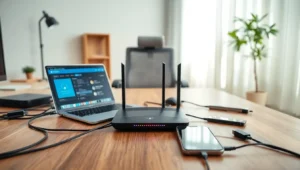In a world where takeout menus seem to multiply faster than rabbits, meal planner apps swoop in like culinary superheroes. They save busy folks from the dreaded “What’s for dinner?” dilemma, making meal prep as easy as pie—without the calories. Imagine having a personal chef at your fingertips, ready to whip up delicious meals tailored to your tastes and dietary needs.
Meal planner apps aren’t just about saving time; they’re about unleashing creativity in the kitchen. With a few taps, users can explore new recipes, track their grocery lists, and even manage their nutrition. So why not ditch the chaos and embrace the joy of cooking? Dive into the world of meal planning, where every week can be a delightful culinary adventure, and the only thing you’ll need to worry about is whether to go for seconds.
Table of Contents
ToggleOverview of Meal Planner Apps
Meal planner apps simplify the cooking process by offering a variety of features that enhance meal preparation. Users benefit from personalized recipe suggestions tailored to their preferences and dietary needs. With these apps, meal planning transitions from a chore to an enjoyable task.
Many apps also include grocery list management. This feature enables users to compile ingredient lists for efficient shopping trips. Organized grocery lists help eliminate unnecessary purchases, saving both time and money.
Tracking nutrition represents another essential function of meal planner apps. They allow users to monitor calorie intake and nutritional balance. This tracking aids individuals in maintaining healthy eating habits and reaching fitness goals.
Some popular meal planner apps include Mealime, Yummly, and Paprika. Each app offers unique features, such as meal prep timers, shopping list integrations, and social sharing options. Users can explore their creative side with diverse recipes and cooking techniques.
Accessibility plays a crucial role in the appeal of meal planner apps. Available on various platforms, these apps can be used on smartphones, tablets, and computers. This flexibility ensures users can plan meals and manage their diets anytime, anywhere.
Informed decisions regarding food choices and grocery shopping become easier with the support of meal planner apps. By providing structure and inspiration, these applications help users develop healthy habits and enjoy cooking. Embracing technology in meal planning creates a satisfying culinary experience, encouraging exploration and creativity in the kitchen.
Key Features to Consider
Meal planner apps come with essential features that enhance user experience and facilitate meal management effectively. Users benefit from intuitive designs that streamline navigation, making cooking and planning enjoyable. Accessibility plays a crucial role; responsive layouts ensure usability on various devices, from smartphones to tablets.
User Interface and Experience
A user-friendly interface greatly impacts the overall experience. Clear navigation menus allow quick access to recipes, grocery lists, and meal plans. Attractive visuals, including high-quality images of dishes, enhance engagement. Features like customizable themes or dark mode cater to personal preferences, improving user satisfaction. Alert notifications for upcoming meals or prep reminders encourage timely actions, minimizing last-minute rushes.
Customization Options
Personalization matters significantly in meal planning. Users appreciate the ability to set dietary preferences and restrictions, tailoring meal suggestions accordingly. Recipe filters allow searches based on cuisine, ingredients, or cooking time, simplifying selection. Meal plans can adapt based on preferences, such as vegan or gluten-free options. Users enjoy saving favorite recipes for easy retrieval, ensuring quick reference during meal preparation.
Nutritional Tracking
Nutritional tracking forms a vital component for health-conscious individuals. Users can monitor calorie intake, macronutrient distribution, and vitamin levels easily. Integration with fitness apps provides a comprehensive overview of dietary habits and exercise routines. Users may access a food diary feature to record daily meals and snacks, promoting mindfulness about choices. Detailed reports help users understand their nutritional balance and make informed adjustments as needed.
Popular Meal Planner Apps
Numerous meal planner apps stand out in the market, providing unique features and benefits tailored to different user needs. Below are three popular apps that enhance meal planning experiences.
App 1: Mealime – Features and Pros
Mealime boasts an intuitive interface, simplifying meal prep with easy-to-follow recipes. Users can customize meal plans based on dietary preferences, including vegetarian and gluten-free options. The app generates grocery lists automatically, making shopping trips more efficient. Additionally, Mealime encourages creativity in the kitchen by offering a diverse recipe database, ensuring there’s always something new to try. Users appreciate the time-saving aspect, especially busy individuals seeking quick and nutritious meal solutions.
App 2: Yummly – Features and Pros
Yummly shines with its personalized recipe recommendations tailored to individual tastes. Users benefit from an extensive library of recipes, complete with cooking videos for visual learners. The app’s smart shopping list feature organizes grocery items, reducing time spent at the store. Yummly integrates nutritional tracking, helping users maintain their health goals by monitoring calorie intake and macronutrient distribution. Seamless social sharing options allow users to connect with friends and share favorite recipes, fostering a sense of community around cooking.
App 3: Paprika – Features and Pros
Paprika offers advanced organizational tools, allowing users to save recipes from any website effortlessly. The built-in meal planner makes it easy to visualize what to cook throughout the week. Users can adjust serving sizes, and Paprika recalculates ingredient quantities automatically, promoting flexibility in meal preparation. A powerful grocery list feature categorizes items, enhancing shopping efficiency. The app’s offline access ensures users can plan and cook meals even without an internet connection, making it a reliable companion for culinary adventures.
Benefits of Using Meal Planner Apps
Meal planner apps simplify the cooking experience by providing tailored suggestions that align with individual tastes and dietary needs. Time management becomes more efficient as users can quickly generate meal ideas without prolonged decision-making. Creativity in the kitchen flourishes because these apps encourage users to explore new recipes and cooking techniques. Additionally, grocery list management significantly reduces shopping time while preventing unnecessary purchases, translating to cost savings.
Nutrition tracking allows users to monitor their calorie intake and evaluate their dietary habits effectively. Maintaining a balanced diet supports fitness goals, fostering a healthier lifestyle over time. Popular apps like Mealime, Yummly, and Paprika enhance these benefits through unique features such as meal prep timers and integrated social sharing options. Accessibility across platforms ensures users can manage their meal planning and diets wherever they go.
A user-friendly interface improves engagement by incorporating attractive visuals and easy navigation. Customizable themes provide aesthetic appeal while alert notifications assist users in organizing their meal schedules. Personalization plays a crucial role, enabling them to set dietary preferences and filter recipes based on specific criteria.
Integrating nutritional tracking with fitness apps offers users a comprehensive overview of their eating patterns. Meal planner apps ultimately deliver structure and inspiration, enabling informed food choices and the development of healthy habits. Cooking transforms from a chore into an enjoyable activity, inviting users to discover their culinary creativity.
Potential Drawbacks
Meal planner apps offer numerous benefits but come with potential drawbacks. Complexity in usage can pose challenges, particularly for individuals not familiar with technology. Some users may find navigation overwhelming, especially in apps packed with features.
Costs can add up with premium versions of popular apps. While many apps provide free options, advanced functionalities often require subscriptions or one-time purchases. Users aiming for extensive customization may hesitate at additional expenses.
Limited recipe databases affect some apps. Certain platforms do not host a diverse selection of recipes, which may restrict culinary exploration. Users seeking variety in meal planning might find these limitations frustrating.
Nutritional tracking can present inaccuracies. Some databases might lack comprehensive information, leading to incorrect calorie counts or macronutrient breakdowns. Individuals focusing on precise nutritional goals may struggle with discrepancies in data.
Finally, over-reliance on technology may diminish cooking skills. Users using meal planner apps extensively might become dependent on digital guidance, potentially impacting their ability to improvise in the kitchen. Those desiring to enhance their culinary skills should remain cautious about becoming too reliant on app suggestions.
Awareness of these drawbacks is essential when choosing a meal planner app. Evaluating options based on personal preferences ensures a smoother experience while maximizing the app’s benefits.
Conclusion
Meal planner apps have revolutionized the way people approach cooking and meal preparation. By offering personalized meal suggestions and streamlined grocery management, they not only save time but also inspire culinary creativity. These tools make it easier to maintain healthy eating habits while keeping meal planning enjoyable.
Despite some challenges like complexity and potential inaccuracies, the advantages of using meal planner apps far outweigh the drawbacks. With the right app, users can transform their cooking experience and foster a healthier lifestyle. Embracing these digital tools can lead to a more organized kitchen and a more satisfying relationship with food.





